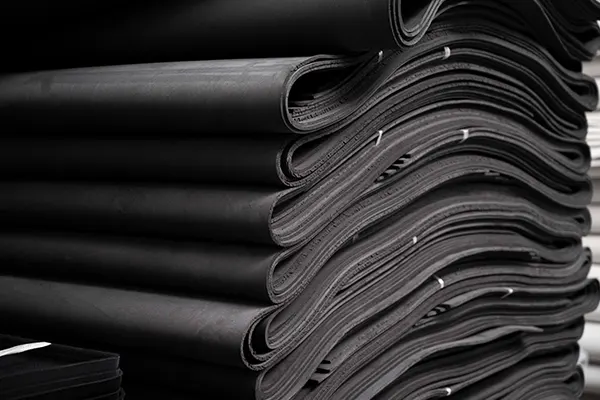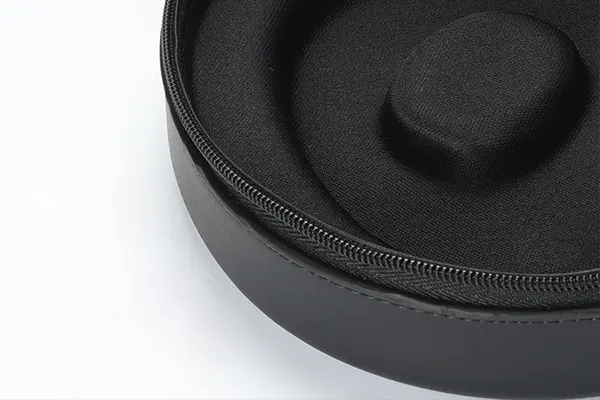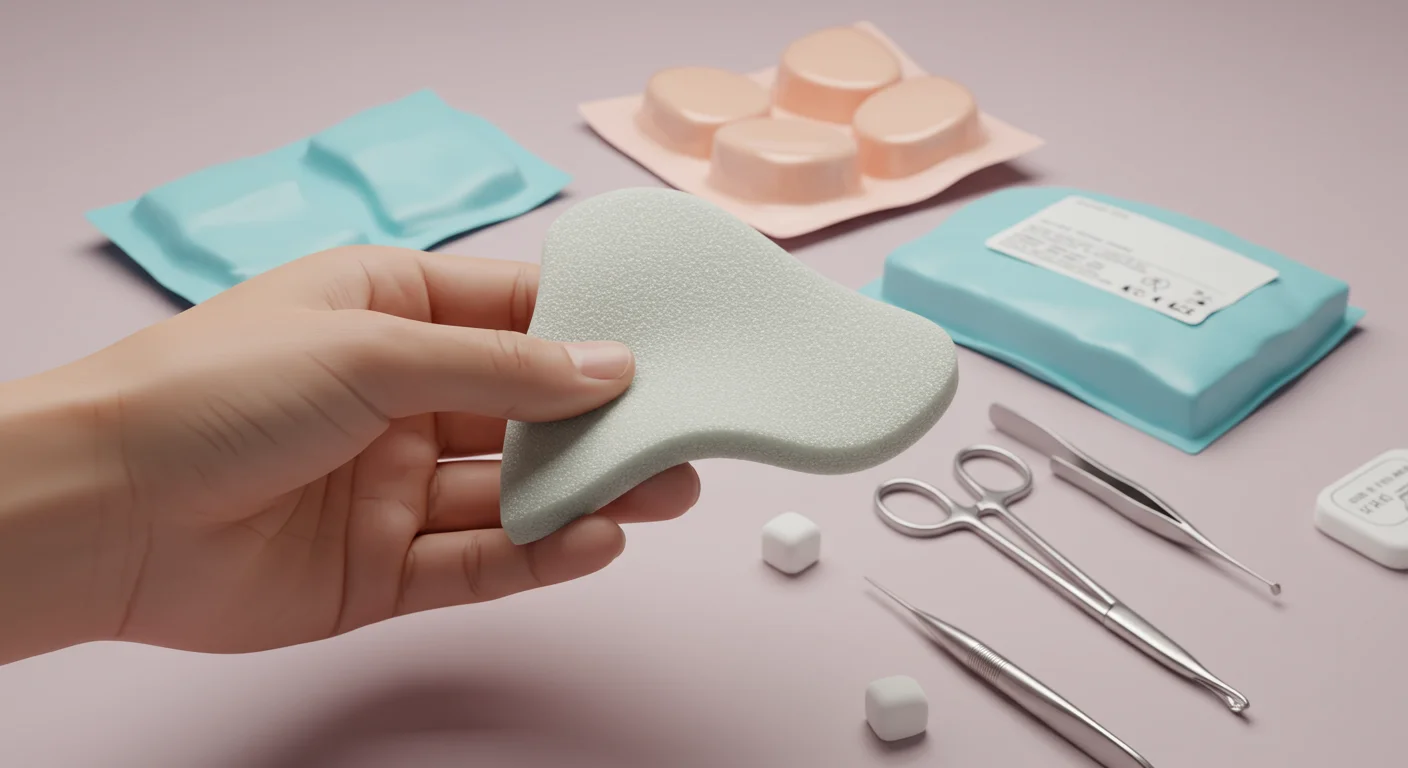في عالم المواد, يحمل EVA و PVC موقعًا مهمًا بسبب طبيعتهما التنوعية وتطبيقاتها المتنوعة. في حين أن كلا المادتين لهما خصائص ومزايا مميزة خاصة بهما, يعد فهم الاختلافات الرئيسية أمرًا ضروريًا لاتخاذ قرارات مستنيرة في مختلف الصناعات. في هذه المقالة, سوف نتعمق في التكوين, ملكيات, وتطبيقات EVA و PVC. عن طريق كشف الألغاز وراء هذه المواد, نأمل أن نوفر لك المعرفة اللازمة لاختيار المادة المناسبة لتلبية احتياجاتك المحددة.
ما هي مادة إيفا?

إيفا, اختصار لخلات الإيثيلين فينيل, هو كوبوليمر مصنوع من بلمرة الإيثيلين ومونومرات أسيتات الفينيل. هذا التكوين هو ما يعطي Eva خصائصه الفريدة. يوفر الإيثيلين صلابة ومرونة ممتازة, بينما يعزز خلات الفينيل التصاق والاستقرار الحراري. علاوة على ذلك, تحدد نسبة الإيثيلين إلى محتوى خلات الفينيل صلابة ونعومة مادة EVA. عمومًا, كلما زاد محتوى خلات الفينيل, كلما تصبح إيفا أكثر ليونة وأكثر مرونة.
ما هي مادة PVC?

بولي كلوريد الفينيل, أو كلوريد البولي فينيل, هو بوليمر بالحرارة اصطناعي يتكون من وحدات تكرار من كلوريد الفينيل. يمنح تكوين PVC القدرة على تحمل مجموعة متنوعة من الظروف البيئية, مما يجعلها واحدة من أكثر المواد تنوعا في الصناعة. مقاومة كيميائية ممتازة, الخصائص الميكانيكية, وقد جعلت المتانة PVC عنصر أساسي في العديد من القطاعات.
إيفا مقابل. بولي كلوريد الفينيل: عملية التصنيع
مواد إيفا يتم تصنيعها من خلال عملية تعرف باسم بلمرة عالية الضغط من إيثيلين ومونومرات أسيتات الفينيل. تتضمن هذه العملية استخدام محفز لبدء رد الفعل, مما أدى. يتم تحديد تركيبة المواد النهائية عن طريق التحكم بعناية في نسبة الإيثيلين إلى أسيتات الفينيل أثناء عملية البلمرة.
على الجانب الآخر, يتم إنتاج PVC من خلال عملية تسمى بلمرة التعليق. في هذه الطريقة, يتم تعليق مونومرات كلوريد الفينيل في الماء, ويتم تقديم البادئ الجذري الحر لبدء تفاعل البلمرة. ثم تتم معالجة راتنج PVC الناتج بشكل أكبر لتحقيق الخصائص والخصائص المطلوبة. تجدر الإشارة إلى أن هناك تقنيات إنتاج بديلة مثل بلمرة المستحلب والبلمرة السائبة, لكل منها مزاياها وخصائصها.
إيفا مقابل. بولي كلوريد الفينيل: متانة


يظهر إيفا مرونة رائعة ومقاومة للبلى, مما يجعلها خيارًا ممتازًا لمنتجات مثل قضية إيفا التي تخضع للاستخدام المتكرر ومتانة الطلب. يوفر بنية كوبوليمر من EVA توازنًا بين القوة والمرونة, السماح لها بتحمل القوى الخارجية دون تشوه أو كسر. تضمن صلابةها الكامنة أن تحافظ مواد EVA على شكلها ونزاهتها حتى في ظل الظروف القاسية.
بالمقارنة, PVC تمتلك قوة استثنائية وتحمل, تمكينها من تحمل الأحمال الثقيلة والإجهاد البدني. توفر القوى الجزيئية القوية لـ PVC مقاومة ممتازة للتأثير, جعلها مناسبة للتطبيقات التي تتطلب النزاهة الهيكلية. سواء كانت أنابيب, الكابلات, أو مواد التسقيف, إن متانة PVC تجعلها خيارًا موثوقًا لحلول طويلة الأمد.
إيفا مقابل. بولي كلوريد الفينيل: المرونة والمرونة
مرونة إيفا المتأصلة هي واحدة من مزاياه الأساسية. بسبب محتوى خلات الفينيل العالي, إيفا تعرض طبيعة ناعمة ومرنة, السماح له تتوافق مع مختلف الأشكال والخطوط. هذا التنوع يجعل EVA مادة مثالية للمنتجات التي تتطلب المرونة وسهولة الاستخدام, مثل الأحذية, المعدات الرياضية, ومواد التعبئة والتغليف.
على العكس, تمكنها مرونة PVC من استرداد شكله الأصلي بعد التشوه. هذه الخاصية تجعل PVC مناسبة للتطبيقات التي تنطوي على الانحناء أو التمدد, مثل الهياكل القابلة للنفخ, خراطيم, وحشيات. قدرة PVC على الحفاظ على مرونتها على مدى واسع من درجات الحرارة توسع تطبيقاتها المحتملة في الصناعات المتنوعة.
إيفا مقابل. بولي كلوريد الفينيل: المقاومة الكيميائية
تمتلك مواد EVA مقاومة ممتازة لمجموعة واسعة من المواد الكيميائية والمذيبات. هذه المرونة تجعل إيفا خيارًا مثاليًا للمنتجات التي تتلامس مع مواد مختلفة, مشتمل وكلاء التنظيف, زيوت, والأحماض. بالإضافة إلى ذلك, مقاومة إيفا العفن والعفن يعزز النمو متانته وطول العمر.
بولي كلوريد الفينيل, على غرار إيفا, يعرض مقاومة كيميائية رائعة. يمكن أن تحمل التعرض ل الأحماض, القلويات, وغيرها من المواد المسببة للتآكل دون تدهور. تتيح هذه الجودة استخدام PVC في التطبيقات الحرجة التي يكون التعرض الكيميائي مصدر قلق, مثل حاويات التخزين الكيميائي, معدات المختبر, وأنظمة الأنابيب.
إيفا مقابل. بولي كلوريد الفينيل: مقاومة الماء

من حيث مقاومة الماء, يثبت إيفا أنه فعال للغاية. بنية كوبوليمر من إيفا, مع بناء رغوة الخلية المغلقة, يمنع امتصاص المياه ويعمل كحاجز ضد الرطوبة. هذه العقار يجعل EVA مادة مثالية لتطبيقات العزل المائي في الصناعات مثل البناء, البحرية, والعتاد في الهواء الطلق.
بصورة مماثلة, يفتخر PVC بقدرات عزل استثنائية. بسبب انخفاض نفاذية ومقاومة امتصاص الماء, PVC هو الخيار الأمثل للتطبيقات التي تكون فيها حماية الرطوبة أمرًا بالغ الأهمية. من أغشية التسقيف إلى ملابس المطر, تضمن خصائص العزل المائي في PVC سلامة وطول المنتجات النهائية.
إيفا مقابل. بولي كلوريد الفينيل: مقاومة الأشعة فوق البنفسجية
واحدة من الخصائص المثيرة للاهتمام لـ EVA هي مقاومة الأشعة فوق البنفسجية. إن قدرة إيفا على تحمل التعرض المطول لأشعة الشمس دون تدهور يجعلها خيارًا ممتازًا للتطبيقات الخارجية. تضمن مقاومة الأشعة فوق البنفسجية أن تحافظ مواد EVA على خصائصها الفيزيائية وعلم الجمال, حتى عند التعرض لأشعة الشمس القاسية لفترات طويلة. أدت هذه الجودة إلى استخدام EVA في الأثاث الخارجي, الألواح الشمسية, ومكونات السيارات.
بصورة مماثلة, PVC يمتلك مقاومة بالأشعة فوق البنفسجية البارزة, مما يجعلها مناسبة للتطبيقات التي تتطلب تعرضًا طويلًا لأشعة الشمس. إضافة مثبتات الأشعة فوق البنفسجية أثناء عملية التصنيع تعزز مرونة PVC لإشعاع الأشعة فوق البنفسجية, ضمان أنها تحتفظ بنزاهة ومظهرها الهيكلي مع مرور الوقت. تتضمن التطبيقات التي تستفيد من مقاومة الأشعة فوق البنفسجية PVC ملفات تعريف النوافذ, سياج, واللافتات في الهواء الطلق.
إيفا مقابل. بولي كلوريد الفينيل: العزل الحراري

مواد EVA معرض خصائص العزل الحراري الرائعة, جعلها مطلوبة للغاية في الصناعات التي تتطلب التحكم في درجة الحرارة. بنية الخلية المغلقة من إيفا تقلل من نقل الحرارة, وبالتالي توفير عزل ممتاز ضد درجات الحرارة الباردة والساخنة. هذه المميزة تجد تطبيقات في الصناعات مثل التعبئة والتغليف, السيارات, والبناء.
بدلاً عن ذلك, PVC يمتلك مستوى معتدل من العزل الحراري. رغم أنها ليست فعالة مثل EVA من حيث العزل, PVC لا تزال توفر مقاومة حرارة ملحوظة. إن قدرتها على الحفاظ على خصائصها الميكانيكية في درجات حرارة مرتفعة تجعل PVC مناسبة للتطبيقات التي تنطوي على نقل الحرارة, مثل العزل الكهربائي, الأنابيب, وكسوة.
إيفا مقابل. بولي كلوريد الفينيل: يكلف
عند النظر في الجدوى الاقتصادية لاستخدام مواد EVA, من الضروري تقييم الفوائد التي تقدمها المادة. بينما قد يكون لدى إيفا أ التكلفة الأولية الأعلى مقارنة بالمواد الأخرى, لها المتانة الممتازة, المرونة, ومقاومة المواد الكيميائية وإشعاع الأشعة فوق البنفسجية تساهم في فعاليتها من حيث التكلفة على المدى الطويل. يضمن طول المنتجات المصنوعة من EVA انخفاض تكاليف الصيانة والاستبدال, مما يجعلها قابلة للحياة اقتصاديا الاختيار لمختلف الصناعات.
على الجانب الآخر, عروض PVC فعالية التكلفة بسبب انخفاض تكاليف المواد الخام وتكاليف الإنتاج. بالإضافة إلى ذلك, تساهم متانة PVC وعمرها الطويل في فعاليتها التكلفة الإجمالية. القدرة على تحمل الظروف الجوية القاسية ومقاومة التدهور الكيميائي تقلل من تكاليف الصيانة وتمتد عمر المنتجات المصنوعة من PVC.
إيفا مقابل. بولي كلوريد الفينيل: التأثير البيئي

تكمن الصدفة البيئية لـ EVA في Recyclabality. مواد إيفا قابلة لإعادة التدوير بسهولة, تمكين إعادة استخدام الموارد وتقليل النفايات. بالإضافة إلى, بدأ بعض الشركات المصنعة في إنتاج EVA باستخدام موارد متجددة, مزيد من التقليل من التأثير البيئي. إن قابلية إعادة التدوير وطرق الإنتاج المستدامة المرتبطة بـ EVA تجعلها خيارًا واعيًا بيئيًا.
تدور الاعتبارات البيئية لـ PVC حول عملية التصنيع الخاصة بها, سمية محتملة, وقدرات إعادة التدوير. في حين أن إنتاج PVC يولد غاز الكلور, يتم اتخاذ خطوات لتقليل إصدارها إلى الحد الأدنى في البيئة. بالإضافة إلى ذلك, تم إجراء التطورات في تطوير تقنيات إعادة التدوير البديلة لـ PVC, السماح باستخدام أكثر استدامة للمادة. يتضمن تقييم التأثير البيئي لـ PVC النظر في دورة الحياة الكاملة للمادة, بما في ذلك متانته وإعادة تدويره.
إيفا مقابل. بولي كلوريد الفينيل: التطبيقات والصناعات
تجد مواد EVA تطبيقًا في مختلف الصناعات, مشتمل تصنيع الأحذية, البضائع الرياضية, السيارات, التغليف, وحتى الرعاية الصحية. المرونة, متانة, ومقاومة المواد الكيميائية وإشعاع الأشعة فوق البنفسجية تجعل إيفا مادة متعددة الاستخدامات يمكن تصميمها لتلبية احتياجات محددة. استخدامه في باطن الأحذية, منصات رغوة إيفا, تعرض الحالات الوقائية والمعدات الطبية قدرتها على التكيف عبر القطاعات المتنوعة.
تمتد تطبيقات PVC على نطاق واسع من الصناعات, تغطية بناء, كهربائي, السيارات, والرعاية الصحية. متانة المادة, المقاومة الكيميائية, وتساهم فعالية التكلفة في استخدامها الواسع. يجد PVC طريقه إلى إطارات النوافذ, الأنابيب, الكابلات, أكياس الدم, والعديد من المنتجات الأخرى التي تتطلب مزيجًا من المرونة والقدرة على تحمل التكاليف.
إيفا مقابل. مواد PVC, أيهما أفضل?
عندما يتعلق الأمر باختيار المادة المناسبة لتطبيق معين, الاختيار بين إيفا (أسيتات الفينيل الإيثيلين) و PVC (كلوريد البولي فينيل) غالبًا ما ينشأ. كلا المادتين يمتلكان خصائص فريدة, جعلها مناسبة لمختلف الصناعات والأغراض.
فوائد المواد EVA:
- المرونة والمرونة
- المتانة والمرونة
- المقاومة الكيميائية
- مقاومة الماء والعزل المائي
- مقاومة الأشعة فوق البنفسجية
- العزل الحراري
- قابلية إعادة التدوير والود البيئي
فوائد المواد PVC:
- القوة والتحمل
- المقاومة الكيميائية
- مقاومة الماء والعزل المائي
- مقاومة الأشعة فوق البنفسجية
- مقاومة حرارة معقولة
- فعالية التكلفة
- قابلية إعادة التدوير والاستدامة
للمشاريع التي تعطي الأولوية للمرونة, سهولة الاستخدام, وإعادة تدوير, قد يكون إيفا هو الخيار المفضل. على الجانب الآخر, عند المتانة, قوة, وفعالية التكلفة هي اعتبارات رئيسية, قد يكون PVC هو الخيار الأفضل. من الضروري تقييم الخصائص والقيود الفريدة لكل مادة بعناية والنظر في كيفية توافقها مع الاستخدام المقصود لتحديد المواد الأكثر ملاءمة.
خاتمة
ختاماً, يعد فهم الاختلافات الرئيسية بين مواد EVA و PVC ضروريًا لاتخاذ قرارات مستنيرة في مختلف الصناعات. بينما تظهر EVA مرونة ملحوظة, مقاومة الأشعة فوق البنفسجية, وإعادة تدوير, PVC تفتخر متانة ممتازة, المقاومة الكيميائية, وفعالية التكلفة. من خلال تقييم المتطلبات المحددة لكل تطبيق, يمكن للمرء اختيار المواد الأنسب لتحقيق النتائج المرجوة. سواء كان ذلك براعة EVA أو موثوقية PVC, يعتمد الاختيار في النهاية على إيجاد التوازن الصحيح بين الوظيفة, طول العمر, والجدوى الاقتصادية.
















